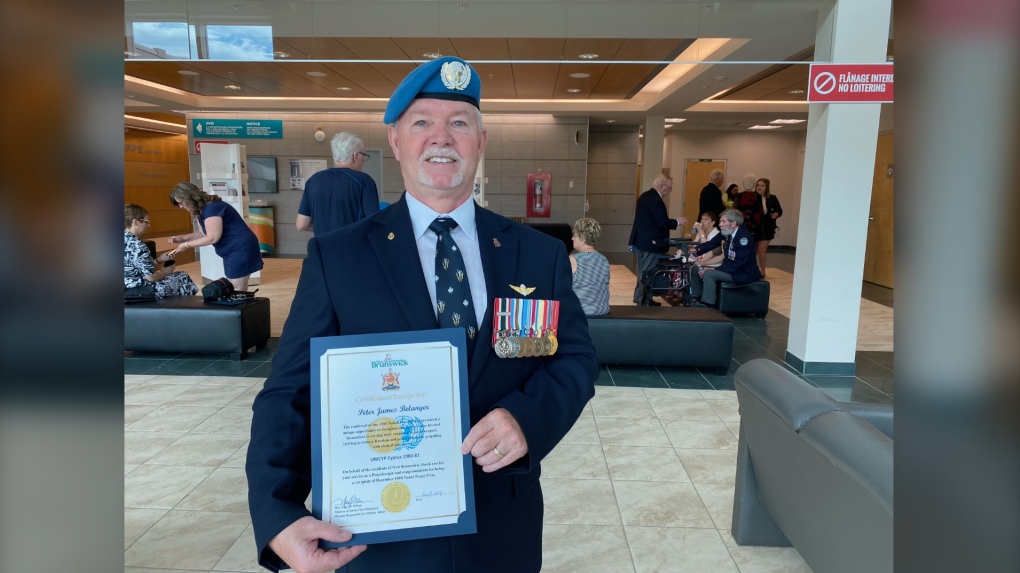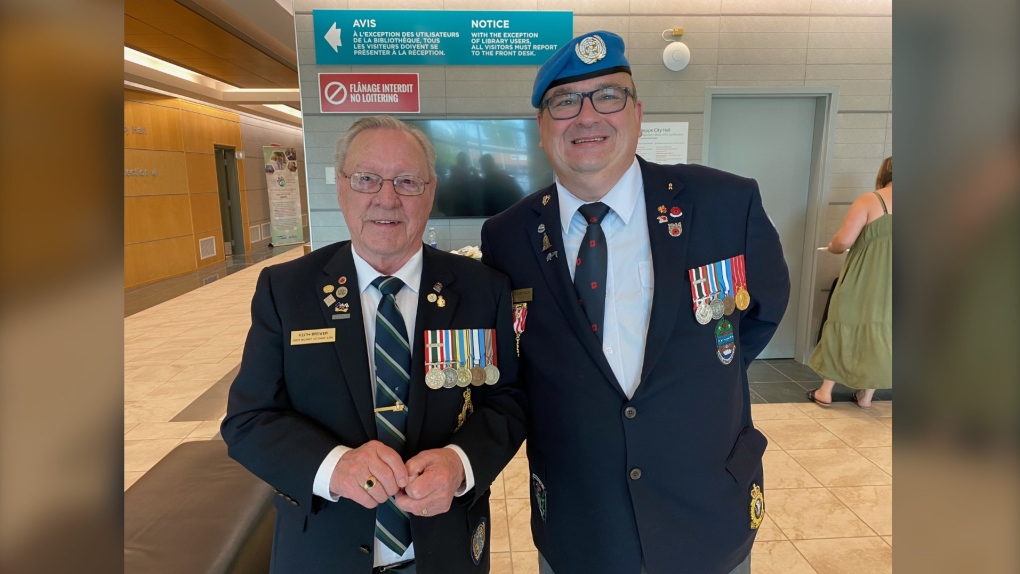'It's about the uniform': Blue berets honoured at Dieppe ceremony
Although most of the men honoured Monday morning in Dieppe never served together, there’s still an incredible bond among all the former soldiers who wore the blue beret.
A ceremony recognizing United Nations [UN] peacekeepers who received the 1988 Nobel Peace Prize took place at city hall in front of family and friends.
The honour was originally given almost 35 years ago to acknowledge the contributions peacekeepers serving under the UN flag made to keep peace and security in war-torn countries.
Retired Chief Warrant Officer Peter Belanger served on peacekeeping missions in Cyprus, Syria, Kuwait and the former Yugoslavia.
Belanger said it was an honour to receive the medals given to him and his colleagues from the UN and to be recognized once again Monday morning in Dieppe.
“It was just a pleasure to serve Canada all these years. No regrets and I would do it again in a heartbeat,” said Belanger.
 Retired Chief Warrant Officer Peter Belanger holds a certificate of recognition. (CTV/Derek Haggett)Peacekeepers were not sent on combat missions, but were still very much in harm’s way.
Retired Chief Warrant Officer Peter Belanger holds a certificate of recognition. (CTV/Derek Haggett)Peacekeepers were not sent on combat missions, but were still very much in harm’s way.
“It’s a peace mission, but it’s not always peaceful because you always have the two parties that want to do harm to each other and you’re there for peace,” said Retired Cpl. Mario Castonguay, who served in Cyprus in 1985. “Anything could happen.”
According to the federal government, over a half-a-million troops from 53 different nations were deployed on peacekeeping missions after the Second World War.
More than 125,000 of them were members of the Canadian Armed Forces.
Some operations were more dangerous than others with more than 730 peacekeepers killed, including approximately 130 Canadians.
One of the best-known operations was in Cyprus, where Canadians were first sent in 1964, tasked with the job of keeping the peace between the Turks and Greeks.
While in Cyprus, Belanger said they were always on high alert.
“The Turkish military at the time were very disciplined. Come the evening, armed guards, they were always armed, but they were much more vigilant to the point where they would point their rifles at us from time to time,” said Belanger.
Belanger said they had to make sure they were always well represented.
“We had our UN badges, we were in our UN vehicles and that went fairly well for the most part,” said Belanger.
Castonguay said at times the atmosphere was actually very friendly in Cyprus.
“You’re just a bunch of people, maybe 600, when the unit goes there. You hold yourself together. It’s something that you can’t compare when you’re on a base. It’s completely different,” said Castonguay.
 Retired Cpl. Keith Brewer (left) and retired Cpl. Mario Castonguay (right) pose for a photo. (CTV/Derek Haggett)Retired Cpl. Keith Brewer served in Egypt on the Gaza Strip in the mid-1960s and Cyprus in 1967.
Retired Cpl. Keith Brewer (left) and retired Cpl. Mario Castonguay (right) pose for a photo. (CTV/Derek Haggett)Retired Cpl. Keith Brewer served in Egypt on the Gaza Strip in the mid-1960s and Cyprus in 1967.
He called Cyprus a “great country” that was in a lot of turmoil.
“It was nice there, but it was like every other peace mission. It had its hazards. We had to be careful,” said Brewer.
The former soldiers served in different countries and in different eras but the bond they share is similar.
They all know each other from Remembrance Day ceremonies and other military functions and events at the Legion.
“Veterans are a very close-knit family,” said Brewer. “We stick together regardless of the unit you served with. It’s always been that way.”
Belanger said once you meet ex-military people, whether you served with them or not, you become family.
“It’s about the uniform and we know what we’ve gone through and the sacrifices we made together and it just forms a bond that is unbreakable with soldiers,” said Belanger.
It was a tough job far away from home and their families, but the men honoured Monday did more than their part to keep the peace.
For more New Brunswick news visit our dedicated provincial page.
CTVNews.ca Top Stories

Canada crashes out of world juniors in quarterfinals for second straight year
Canada has been eliminated from the world junior hockey championship with a 4-3 loss to Czechia in the quarterfinals.
Pickering pausing in-person meeting due to alt-right threats, mayor says
Pickering Mayor Kevin Ashe says the city is pausing all in-person meetings, moving them to a virtual format, for the time being due to “alt-right” threats.
Athabasca 'chop shop' bust yields millions in stolen vehicles, heavy equipment: RCMP
RCMP have made what they call a "major recovery" of stolen property in Athabasca.
2 dead and 18 injured in Southern California plane crash
Two people died and 18 were injured Thursday when a small plane crashed through the roof of a sprawling furniture manufacturing building in Southern California where at least 200 people were working, police said.
Toys "R" Us Canada closing 5 stores, expand HMV and add play spaces to some shops
Toys 'R' Us Canada says it is closing five Ontario stores and revamping several others as it works to 'optimize' its business.
Wayne Osmond, singer and guitarist for The Osmonds, is dead at 73
Wayne Osmond, a singer, guitarist and founding member of the million-selling family act The Osmonds, who were known for such 1970s teen hits as 'One Bad Apple,' 'Yo-Yo' and 'Down By the Lazy River,' has died. He was 73.
Grieving orca mother Tahlequah carries dead baby for the second time
The famous mother orca who made waves around the world for carrying her dead calf for 17 days has suffered another tragic loss.
Former Liberal cabinet minister Marco Mendicino won't seek re-election
Marco Mendicino, a prominent Toronto member of Parliament and former minister of public safety and immigration, won't run in the next federal election, CTV News has learned.
U.S. soldier shot self in head before Cybertruck exploded outside Trump's Las Vegas hotel, officials say
The highly decorated U.S. army soldier inside a Tesla Cybertruck packed with fireworks that exploded outside Trump International Hotel in Las Vegas shot himself in the head just before detonation, authorities said Thursday.


































